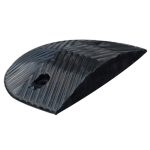
Challenges and Concerns
Impact on emergency vehicles
Speed bumps have been widely used as a means to slow down vehicles and improve road safety. However, one of the major concerns with speed bumps is their impact on emergency vehicles. When responding to emergencies, every second counts, and speed bumps can significantly delay the arrival of emergency vehicles. The jolts and vibrations caused by speed bumps can also affect the stability of medical equipment and compromise the safety of patients being transported. Therefore, it is crucial to carefully consider the placement and design of speed bumps for sale to minimize their negative impact on emergency vehicles while still ensuring the overall safety of the road.
Noise and vibration
Noise and vibration are important considerations when implementing speed bumps as a solution for slowing down vehicles. Speed bumps can generate significant noise and vibrations, especially when vehicles pass over them at high speeds. This can be a concern for residents living near roads with speed bumps, as the constant noise and vibrations can be disruptive and affect their quality of life. Therefore, it is crucial to carefully design and install speed bumps to minimize the noise and vibration levels, ensuring that they effectively slow down vehicles without causing excessive disturbance to the surrounding environment.
Driver discomfort
Driver discomfort is one of the key factors to consider when implementing speed bumps as a solution for slowing down vehicles. Speed bumps are designed to create a jarring effect on vehicles, forcing drivers to slow down significantly. While this may be effective in reducing speed, it can also lead to discomfort for drivers and passengers. The sudden jolt caused by driving over a speed bump can be uncomfortable, especially for those in vehicles with low suspension or sensitive passengers. However, it is this discomfort that serves as a deterrent, reminding drivers to adhere to the speed limit and prioritize safety on the road.
Design and Installation
Proper placement of speed bumps
Proper placement of speed bumps plays a crucial role in effectively slowing down vehicles and ensuring road safety. It is important to strategically position speed bumps in areas where speeding is a concern, such as residential neighborhoods, school zones, and busy intersections. By placing speed bumps in these locations, drivers are forced to reduce their speed, promoting a safer environment for pedestrians and other road users. Additionally, proper placement of speed bumps can help prevent accidents and encourage responsible driving behavior. Overall, careful consideration of where speed bumps are installed is essential for maximizing their effectiveness in controlling vehicle speed.
Materials used for speed bumps
Speed bumps are commonly constructed using various materials to ensure their effectiveness in slowing down vehicles. One of the most commonly used materials for speed bumps is asphalt, which provides a durable and long-lasting solution. Concrete is another popular choice, known for its strength and ability to withstand heavy traffic. Rubber speed bumps are also gaining popularity due to their flexibility and ability to absorb impact. Additionally, some speed bumps are made from recycled materials, promoting sustainability and environmental consciousness. Regardless of the material used, speed bumps play a crucial role in enhancing road safety by reducing vehicle speed and preventing accidents.
Considerations for visibility and signage
When implementing speed bumps as a solution for slowing down vehicles, it is crucial to consider visibility and signage. Proper visibility of speed bumps is essential to ensure that drivers can see them in advance and slow down accordingly. This can be achieved by using reflective materials or painting the speed bumps in bright colors. Additionally, clear signage should be placed to alert drivers of the presence of speed bumps ahead. This will help to prevent accidents and ensure the effectiveness of speed bumps in controlling vehicle speed.
Alternatives to Speed Bumps
Traffic calming measures
Traffic calming measures are essential for ensuring the safety of pedestrians and reducing the speed of vehicles in residential areas. One effective solution that has proven to be successful is the implementation of speed bumps. Speed bumps are raised sections of the road that force drivers to slow down, promoting safer driving habits. They serve as a visual and physical reminder for motorists to adhere to the designated speed limits, especially in areas where children and pedestrians are present. By incorporating speed bumps into traffic calming measures, communities can create a safer environment for everyone and encourage responsible driving.
Roundabouts
Roundabouts are an effective alternative to speed bumps when it comes to slowing down vehicles. Unlike speed bumps, which can cause discomfort and potential damage to vehicles, roundabouts provide a smoother and more efficient traffic flow. They are designed to reduce the speed of vehicles as they navigate the circular intersection, promoting safer driving habits. Additionally, roundabouts help to improve traffic congestion by eliminating the need for traffic lights or stop signs. Overall, roundabouts offer a perfect solution for slowing down vehicles while ensuring a seamless and safe driving experience.
Road narrowing
Road narrowing is an effective strategy to slow down vehicles and improve road safety. By reducing the width of the road, drivers are forced to navigate through a narrower space, which naturally encourages them to reduce their speed. This technique is particularly useful in areas where speeding is a common problem, such as residential neighborhoods or school zones. Road narrowing not only helps to control vehicle speed, but it also creates a visual cue for drivers to be more cautious and attentive. Additionally, it can enhance pedestrian safety by providing shorter crossing distances and discouraging reckless driving behavior. Overall, implementing road narrowing measures can contribute to creating safer and more livable communities.







